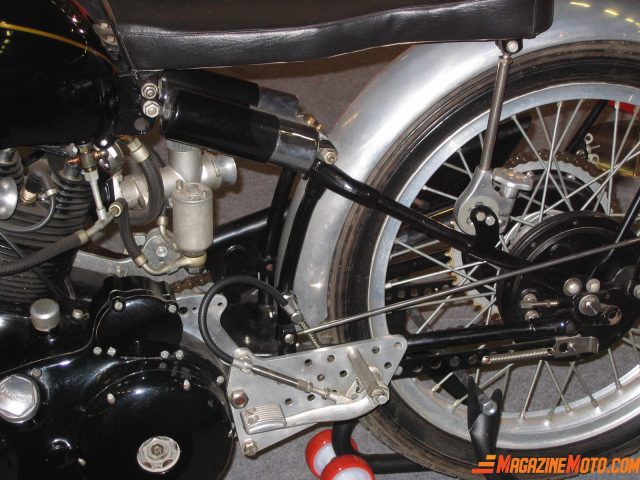Table des matières
ToggleThe vast majority of modern motorcycles, whether off-road or street models, have a single-shock rear suspension. Truly, with the exception of some more « traditional » models, the single shock configuration is the norm today, but this was not always the case.
The A.M.* Period
As you can imagine, in its humble beginnings, the motorcycle was a motorized bicycle. It goes without saying that at that time, over 100 years ago, the very notion of suspension systems had not really materialized in the minds of the designers. Evolution has done its work and many versions of suspension systems, both front and rear, have appeared. On the rear suspension side, the trend was towards a swingarm with two shocks, one on each side, mounted between the arm and the bike’s frame.
*Before Monocross
Phil Vincent sows a seed
While most of the world migrated to a more traditional rear suspension arrangement in the early 20th century, in 1928, a young engineering student, British Phil Vincent, went his own way by inventing (and patenting) the « Vincent Cantilever Suspension ». A suspension that, while retaining the essence of a swingarm and two shock absorbers, was arranged differently.

Lucien Tielgens to the Rescue
The basic concept of the twin-shock swingarm rear suspension continued to evolve, but some shortcomings began to appear, especially (and not surprisingly), on the racetrack. First, the two shocks, no matter how carefully calibrated, do not perform identically, which creates stress and flex in the swingarm. Second, the ratio of rear wheel movement to shock travel was very close, which had the effect of limiting the growth in rear suspension travel. And, on the other hand, it caused the shocks to overheat in more demanding conditions. A Belgian engineering professor named Lucien Tielgens recognized these limitations and came up with a rear suspension design that he believed overcame these deficiencies.

A Defining Moment for Tielgens and Yamaha
In 1972, when Yamaha was making its motocross racing debut on the FIM World Championship circuit, the manufacturer was looking for an edge that would allow it to break through and catapult it to the top of the podium. The invention of Mr. Tielgens came to the ears of the Yamaha race team manager. So, after some discussion and testing, Yamaha bought the patent, giving birth to the new (and revolutionary) rear suspension called Monocross. The positive effects of this marriage were quickly realized and Yamaha (and Hakan Andersson) won its first motocross world championship in 1973 in the 250 cc class with its famous YZM250.

Asphalt Racing Motorcycles
Soon after, asphalt racing motorcycles also benefited from the new suspension and Yamaha launched its famous OW23 mid-season in 1974. Photo: OW23, thumbnail: ridden by the famous Giacomo Agostini, Yamaha won the GP 500 title in 1975, its first title in the premier class. Faced with the high demands of asphalt racing, the triangulation of the rear swingarm, a necessity for the Monocross configuration, and the added stiffness it provides have proven to be an important advantage over the conventional designs used by the competition.
What About Today?
The original Monocross suspension configuration remains in use on only two Yamaha off-road beginner bikes (TT-R 110 and TT-R 50) in 2023. However, the arrival of the Monocross on the scene 50 years ago opened the eyes of the entire industry to the benefits of a single-shock rear suspension. In doing so, it opened the door to the introduction of many other single-shock rear suspensions in the years that followed. To be continued!


